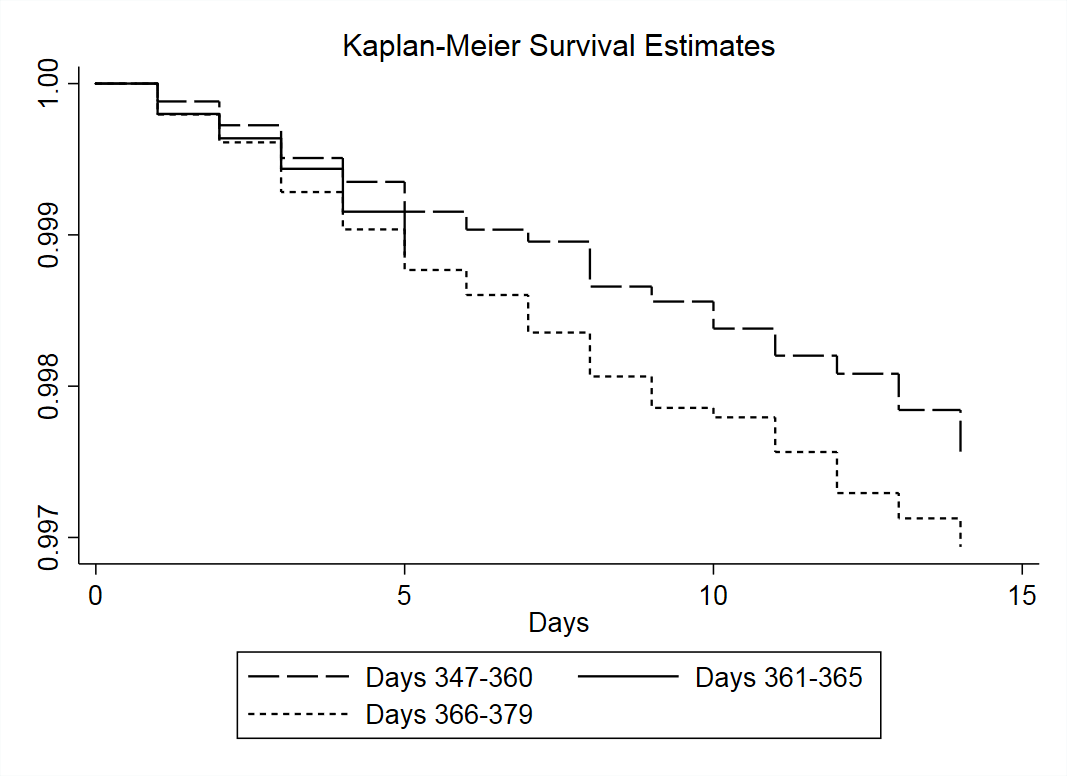Mortality around the One-Year Survival Metric after Liver Transplantation in the United States
1Hospital of the University of Pennsylvania, Philadelphia, PA, 2Brigham and Women’s Hospital, Boston, MA
Meeting: 2019 American Transplant Congress
Abstract number: D15
Keywords: Liver, Liver transplantation, Monitoring, Public policy
Session Information
Session Name: Poster Session D: Quality Assurance Process Improvement & Regulatory Issues
Session Type: Poster Session
Date: Tuesday, June 4, 2019
Session Time: 6:00pm-7:00pm
 Presentation Time: 6:00pm-7:00pm
Presentation Time: 6:00pm-7:00pm
Location: Hall C & D
*Purpose: Liver transplant programs in the United States are evaluated on one-year survival, among other factors. This may create an unintended incentive to continue life-sustaining treatment until after day 365, particularly in programs performing poorly according to national metrics. We assessed for a decrease in mortality rate among liver transplant recipients immediately prior to day 365 and for a subsequent increase shortly thereafter.
*Methods: This was a retrospective cohort study of adult liver transplant recipients from 5/5/2005-3/1/2017 using SRTR. We determined the daily hazard rate of mortality for all recipients, adjusted for clinical and demographic factors. To evaluate if there was a decrease in mortality in the five days preceding day 365 or an increase in mortality in the 14 days following day 365, we performed a second-order Cox proportional regression using adjusted daily hazard ratio (HR) as our outcome variable. We performed an additional sensitivity analysis using a 30-day rather than 14-day interval. These analyses were repeated for programs who were at risk for flagging—defined as an observed to expected HR between 1.1-2.0— according to OPTN.
*Results: The study cohort included 67,245 recipients. There was no significant decrease in the adjusted HR between days 361-365 compared to days 347-360 (HR=1.23 95% CI=0.86-1.74, p=0.24). There was a trend toward an increase in the adjusted HR between days 366-379 (HR=1.25 95% CI=0.99-1.59, p=0.06) (Figure 1). Defining the baseline hazard as the 30 days before days 361-365, there was no significant change in the adjusted HR between days 366-395 (HR=1.05 95% CI=0.88-1.25, p=0.54). Among programs at risk for flagging, there was no change in adjusted HR during days 361-365 or in the 14 days after (HR=0.73 95% CI=0.34-1.56, p=0.42).
Figure 1: Kaplan-Meier survival curves for defined intervals around day 365 following liver transplantation.
*Conclusions: There was no evidence of decreased mortality immediately before the one-year point among adult liver transplant recipients. There was a trend towards increased mortality in the 14 days following day 365, but no significant increase in mortality in the 30 days following day 365. This suggests life-sustaining treatment is likely not being continued due to one-year quality benchmarks.
To cite this abstract in AMA style:
Blebea C, Chatterjee P, Nathan A, Diamond J, Goldberg HJ, Courtwright A. Mortality around the One-Year Survival Metric after Liver Transplantation in the United States [abstract]. Am J Transplant. 2019; 19 (suppl 3). https://atcmeetingabstracts.com/abstract/mortality-around-the-one-year-survival-metric-after-liver-transplantation-in-the-united-states/. Accessed December 17, 2025.« Back to 2019 American Transplant Congress

